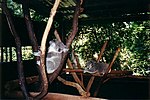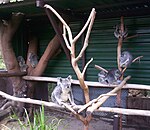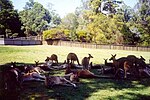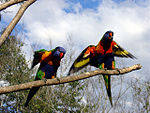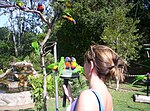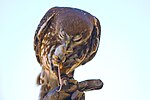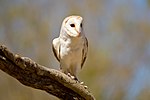
Healesville Sanctuary, formally known as the Sir Colin MacKenzie Sanctuary, is a zoo specialising in native Australian animals. It is located at Healesville in rural Victoria, Australia, and has a history of breeding native animals. It is one of only two places to have successfully bred a platypus, the other being Sydney's Taronga Zoo. It also assists with a breeding population of the endangered helmeted honeyeater.
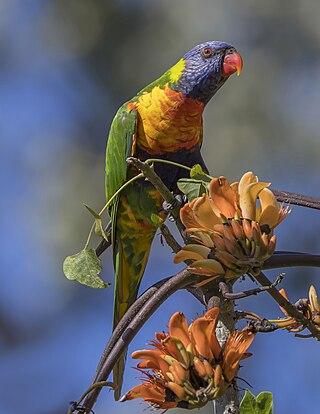
The rainbow lorikeet is a species of parrot found in Australia. It is common along the eastern seaboard, from northern Queensland to South Australia. Its habitat is rainforest, coastal bush and woodland areas. Six taxa traditionally listed as subspecies of the rainbow lorikeet are now treated as separate species.
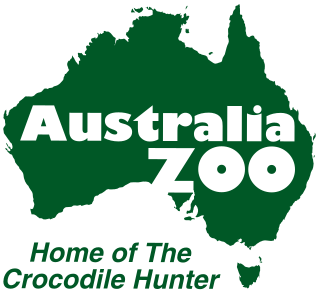
Australia Zoo is a 700-acre (280 ha) zoo in the Australian state of Queensland on the Sunshine Coast near Beerwah/Glass House Mountains. It is a member of the Zoo and Aquarium Association (ZAA), and is owned by Terri Irwin, the widow of Steve Irwin, whose wildlife documentary series The Crocodile Hunter and his family's new show Crikey! It's the Irwins made the zoo a popular tourist attraction.

Currumbin Wildlife Sanctuary is a heritage-listed zoological garden at 28 Tomewin Street, Currumbin, Queensland, Australia. It was built in 1947 onwards. It was added to the Queensland Heritage Register on 18 September 2009. The sanctuary is world-renowned for its feeding of huge flocks of free-flying wild rainbow lorikeets, which come to the sanctuary to feast off the special mixture which the lorikeets eat.

Shoalhaven Zoo, formerly the Nowra Animal Park, is an animal park on the South Coast of New South Wales, Australia.

Moonlit Sanctuary Wildlife Conservation Park is a 25-acre (10 ha) biopark within the Pearcedale Conservation Park located at Pearcedale on the Mornington Peninsula near Melbourne, Australia. It aims to display the fauna that was found in the Mornington Peninsula and Western Port Biosphere Reserve prior to European settlement as well as working towards the recovery of threatened Australian fauna. The park is open all year except on Christmas Day. The sanctuary, as part of Pearcedale Conservation Park, is an institutional member of the Zoo and Aquarium Association (ZAA). It is ECO Certified at the Ecotourism level by Ecotourism Australia.
Halls Gap Zoo is a country 53-acre (21 ha) zoo located about 7 kilometres (4.3 mi) from Halls Gap, Victoria, Australia. From the zoo you can see Grampians National Park. It is Victoria's largest regional zoo, holding over 120 native and exotic species.

The Armadale Reptile Centre is a reptile zoo in Armadale, Western Australia that focuses on herpetology and wildlife endemic to Australia.

Banham Zoological Gardens is a 50-acre (20 ha) zoo in Banham, Norfolk, England. The zoo, which in 2024 was reported to be a home to more than 2,000 animals, opened to the public in 1968, became a charity in 2013, and has since been often awarded the prize of Norfolk's Top Attraction, by numerous different organisations, with an annual visitor attendance of in excess of 200,000 people. It is part of the Zoological Society of East Anglia, a registered charity which also owns Africa Alive Zoological Reserve near Lowestoft, Suffolk.

The Koala Park Sanctuary is a privately owned and run Australian wildlife park on 10 acres in West Pennant Hills, a northern suburb of Sydney. The park is known for its collection of koalas and other Australian animals and is set in a rainforest-like area. It exists to show Australian native animals and birds and teach the public about them. The park receives about 400,000 guests annually.

Featherdale Wildlife Park is a zoo located in Doonside, Sydney, Australia. The park is located in Sydney's west, approximately 40 km (25 mi) from Sydney's CBD. The park contains various species native to Australia, and is known to be one of the world's largest collections of Australian fauna. The facility provides displays, events and interactive experiences. The site covers 3.29 hectares, ranging from animal enclosures and display areas to visitor facilities, including picnic spaces, shops and basic amenities. It specialises in Australian native wildlife and birds, as well as reptiles and marsupials. The premises is accredited by the Zoo Aquarium Association Australia.

Wildlife HQ Zoo, is located at the Big Pineapple, Woombye, Queensland on the Sunshine Coast, Queensland and opened in November 2013. In March 2014 many animals were relocated from the now closed Alma Park Zoo.

Hartley's Crocodile Adventures is a 10-hectare (25-acre) wildlife sanctuary and ecotourism park located between Cairns and Port Douglas at Wangetti in Far North Queensland, Australia. It adjoins the world heritage listed Wet Tropics of Queensland rainforest, through which visitors can take guided or self-guided walks.
Caversham Wildlife Park is a wildlife park currently located in Whiteman Park in Western Australia. It is home to several Australian animals including kangaroos, koalas, possums, wallabies, wombats and Tasmanian devils.

Gorge Wildlife Park is a privately-owned sanctuary in the Australian state of South Australia. It is at Cudlee Creek in the Adelaide Hills and continues to be operated by the same family that established it in 1965. It is 30 km northeast of Adelaide. Situated on 14 acres of land, under shaded trees, paths meander among the largest privately owned collection of Australian animals. The park provides contact with a range of Australian native animals as well as exhibits of Australian and exotic animals and birds. A feature is the opportunity for visitors to hold a koala.

Darling Downs Zoo is a zoo situated in Pilton, Queensland, Australia. The zoo is divided into four separate geographical areas featuring animals mostly from Africa, South America, South-East Asia and Australia.
Ranger Red's Zoo & Conservation Park, formerly Peel Zoo, is a zoo and wildlife sanctuary located on the banks of the Murray River in Pinjarra, Western Australia. It is a member of the Zoo and Aquarium Association.
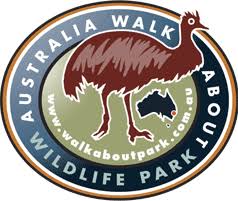
Australia Walkabout Wildlife Park is a wildlife sanctuary located in Calga, New South Wales, Australia. The wildlife park is home to Australian native birds, mammals and reptiles as well as farm animals. It offers research and education programs, with visitors able to undertake day and night tours. The park is home to a wide range of Australian animals and in 2021 became home to a group of meerkats, the park's first exotic animals.
Birdland Animal Park is a wildlife park located on the South Coast of New South Wales, Australia.

Oakvale Wildlife Park is a wildlife park established by the Sansom family in Salt Ash, in the Port Stephens region of New South Wales, Australia. It is home to a variety of animals which, while primarily native species of eastern Australia, includes some exotic species. It also has several children's play facilities, including a water-play area and tractor rides.


